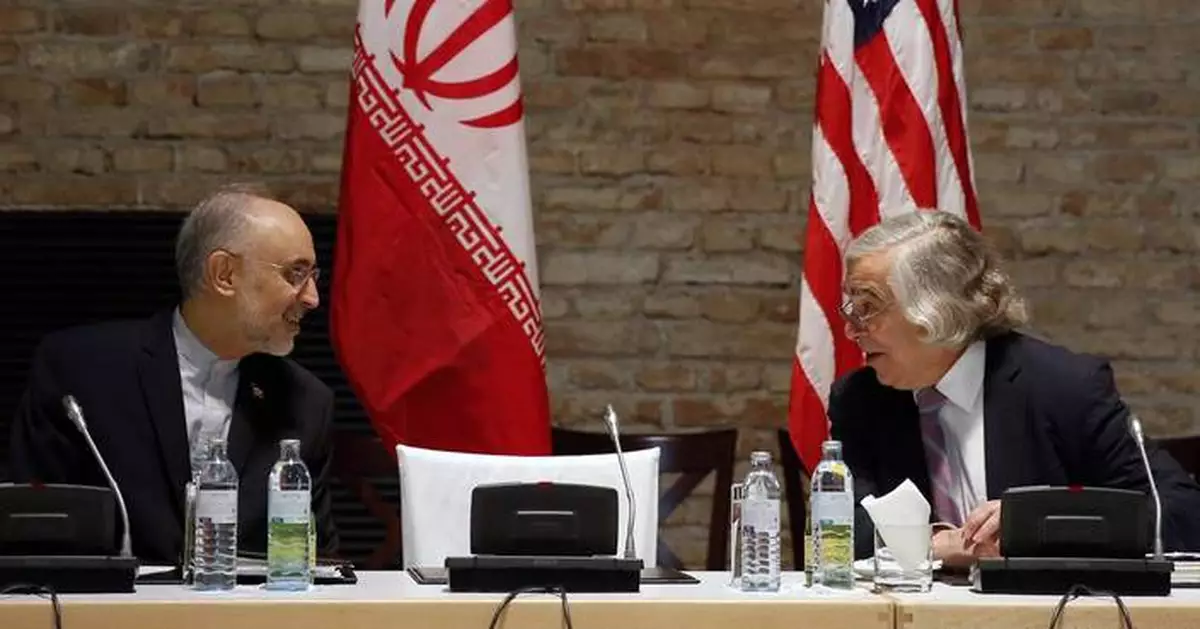MUSCAT, Oman (AP) — Negotiations between Iran and the United States over Tehran's rapidly advancing nuclear program will move Saturday in Oman to what's known as the “expert level” — a sign analysts say shows that the talks are moving forward rapidly.
However, experts not involved in the talks who spoke with The Associated Press warn that this doesn't necessarily signal a deal is imminent. Instead, it means that the talks between Iranian Foreign Minister Abbas Araghchi and U.S. Mideast envoy Steve Witkoff haven't broken down at what likely is the top-level trade — Tehran limiting its atomic program in exchange for the lifting of economic sanctions.
“Agreeing to technical talks suggests both sides are expressing pragmatic, realistic objectives for the negotiations and want to explore the details,” said Kelsey Davenport, the director for nonproliferation policy at the Arms Control Association who long has studied Iran's nuclear program.
“If Witkoff was making maximalist demands during his talks with Araghchi, such as dismantlement of the enrichment program, Iran would have no incentive to meet at the technical level.”
That technical level, however, remains filled with possible landmines. Just how much enrichment by Iran would be comfortable for the United States? What about Tehran's ballistic missile program, which U.S. President Donald Trump first cited in pulling America unilaterally out of the accord in 2018? Which sanctions could be lifted and which would be remain in place on the Islamic Republic?
“The most important determinant of expert talks’ value lies in whether there is a political commitment to do something and experts just need to figure out what," said Richard Nephew, an adjunct fellow at the Washington Institute for Near East Policy who worked on Iran sanctions while at the U.S. State Department during negotiations over what became the 2015 nuclear deal.
"If the experts also have to discuss big concepts, without political agreement, it can just result in spun wheels.”
The 2015 nuclear deal saw senior experts involved in both sides of the deal. For the U.S. under President Barack Obama, Energy Secretary Ernest Moniz reached an understanding working with Ali Akbar Salehi, then the leader of the Atomic Energy Organization of Iran. Both men's technical background proved key to nailing down the specifics of the deal.
Under the 2015 agreement, Iran agreed to enrich uranium only to 3.67% purity and keep a stockpile of only 300 kilograms (661 pounds). Today, Iran enriches some uranium up to 60% purity — a short, technical step away from weapons-grade levels of 90%. The last report by the International Atomic Energy Agency put Iran's overall uranium stockpile in February at 8,294.4 kilograms (18,286 pounds).
The deal also limited the types of centrifuges Iran could spin, further slowing Tehran's ability to rush for a bomb, if it chose to do so. It also set out the provisions of how and when sanctions would be lifted, as well as time limits for the accord itself.
Reaching limits, relief and timelines require the knowledge of experts, analysts say.
“A nonproliferation agreement is meaningless if it cannot be effectively implemented and verified,” Davenport said. “The United States needs a strong technical team to negotiate the detailed restrictions and intrusive monitoring that will be necessary to ensure any move by Iran toward nuclear weapons is quickly detected and there is sufficient time to respond.”
The U.S. expert team will be led by Michael Anton, the director of U.S. Secretary of State Marco Rubio’s policy planning staff. From the Iranian side, Iranian Deputy Foreign Minister Majid Takht-e Ravanchi will lead Tehran’s expert team. Takht-e Ravanchi took part in the 2015 nuclear talks.
Both the Americans and the Iranians have been tightlipped over exactly what's been discussed so far, though both sides have expressed optimism about the pace. However, there has been one noticeable dispute stemming from comments Witkoff made in a television interview, suggesting Tehran could be able to enrich up to 3.67% purity. However, analysts noted that was the level set by the 2015 deal under Obama.
Witkoff hours later issued a statement suggesting that comparison struck a nerve: “A deal with Iran will only be completed if it is a Trump deal.”
“Iran must stop and eliminate its nuclear enrichment and weaponization program,” Witkoff added.
Araghchi responded by warning that Iran must be able to enrich.
"The core issue of enrichment itself is not negotiable,” he said.
Despite that, experts who spoke to the AP said they remained positive about the talks' trajectory so far.
“Although still early stages, I’m encouraged so far,” said Alan Eyre, a former U.S. diplomat once involved in past nuclear negotiations with Tehran. “The pace of negotiations ... is good.”
He added that so far, there didn't appear to be any “mutually exclusive red lines” for the talks as well — signaling there likely wasn't immediately any roadblocks to reaching a deal.
Nephew similarly described reaching the expert level as a “positive sign.” However, he cautioned that the hard work potentially was just beginning for the negotiations.
“They imply the need to get into real details, to discuss concepts that senior (officials) might not understand and to answer questions. I also think too much can be read into them starting,” Nephew said. “Expert talks can sometimes be a fudge for seniors to avoid working on tough issues — ‘let’s have experts discuss it while we move on to other things’ — or to sidestep big political decisions."
Corey Hinderstein, the vice president for studies at the Carnegie Endowment for International Peace and a former U.S. government nuclear expert, described herself as feeling “cautious optimism” over the expert talks beginning.
“Heads of delegation are responsible for setting strategic goals and defining success,” she said. “But if there is a deal to be made, the technical experts are the ones who will get it done.”
The Associated Press receives support for nuclear security coverage from the Carnegie Corporation of New York and Outrider Foundation. The AP is solely responsible for all content.
Additional AP coverage of the nuclear landscape: https://apnews.com/projects/the-new-nuclear-landscape/
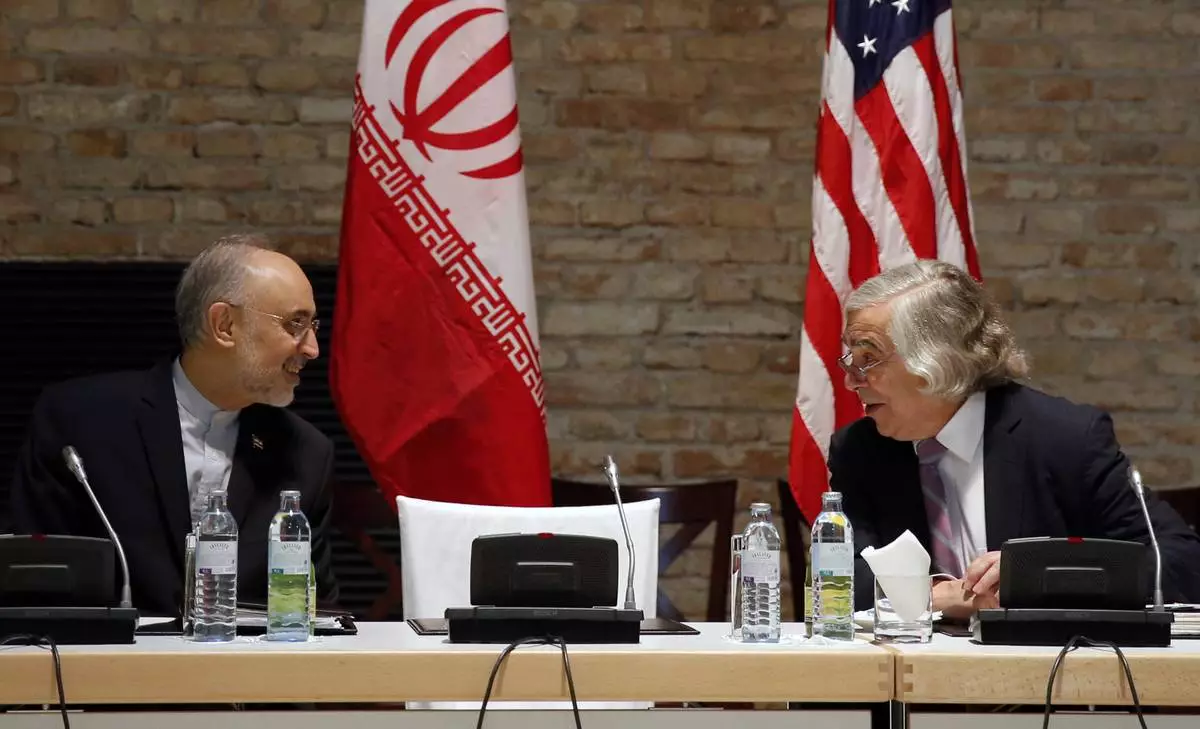
FILE - U.S. Secretary of Energy Ernest Moniz and Head of the Iranian Atomic Energy Organization Ali Akbar Salehi, left, meet at an hotel in Vienna, July 9, 2015. (Carlos Barria/Pool Photo via AP, File)
WASHINGTON (AP) — When the Justice Department lifted a school desegregation order in Louisiana this week, officials called its continued existence a “historical wrong” and suggested that others dating to the Civil Rights Movement should be reconsidered.
The end of the 1966 legal agreement with Plaquemines Parish schools announced Tuesday shows the Trump administration is “getting America refocused on our bright future,” Assistant Attorney General Harmeet Dhillon said.
Inside the Justice Department, officials appointed by President Donald Trump have expressed desire to withdraw from other desegregation orders they see as an unnecessary burden on schools, according to a person familiar with the issue who was granted anonymity because they were not authorized to speak publicly.
Dozens of school districts across the South remain under court-enforced agreements dictating steps to work toward integration, decades after the Supreme Court struck down racial segregation in education. Some see the court orders' endurance as a sign the government never eradicated segregation, while officials in Louisiana and at some schools see the orders as bygone relics that should be wiped away.
The Justice Department opened a wave of cases in the 1960s, after Congress unleashed the department to go after schools that resisted desegregation. Known as consent decrees, the orders can be lifted when districts prove they have eliminated segregation and its legacy.
The Trump administration called the Plaquemines case an example of administrative neglect. The district in the Mississippi River Delta Basin in southeast Louisiana was found to have integrated in 1975, but the case was to stay under the court’s watch for another year. The judge died the same year, and the court record “appears to be lost to time,” according to a court filing.
“Given that this case has been stayed for a half-century with zero action by the court, the parties or any third-party, the parties are satisfied that the United States’ claims have been fully resolved,” according to a joint filing from the Justice Department and the office of Louisiana Attorney General Liz Murrill.
Plaquemines Superintendent Shelley Ritz said Justice Department officials still visited every year as recently as 2023 and requested data on topics including hiring and discipline. She said the paperwork was a burden for her district of fewer than 4,000 students.
“It was hours of compiling the data,” she said.
Louisiana “got its act together decades ago,” said Leo Terrell, senior counsel to the Civil Rights Division at the Justice Department, in a statement. He said the dismissal corrects a historical wrong, adding it’s “past time to acknowledge how far we have come.”
Murrill asked the Justice Department to close other school orders in her state. In a statement, she vowed to work with Louisiana schools to help them “put the past in the past.”
Civil rights activists say that's the wrong move. Many orders have been only loosely enforced in recent decades, but that doesn't mean problems are solved, said Johnathan Smith, who worked in the Justice Department's Civil Rights Division during President Joe Biden's administration.
“It probably means the opposite — that the school district remains segregated. And in fact, most of these districts are now more segregated today than they were in 1954," said Smith, who is now chief of staff and general counsel for the National Center for Youth Law.
More than 130 school systems are under Justice Department desegregation orders, according to records in a court filing this year. The vast majority are in Alabama, Georgia and Mississippi, with smaller numbers in states like Florida, Louisiana and South Carolina. Some other districts remain under separate desegregation agreements with the Education Department.
The orders can include a range of remedies, from busing requirements to district policies allowing students in predominately Black schools to transfer to predominately white ones. The agreements are between the school district and the U.S. government, but other parties can ask the court to intervene when signs of segregation resurface.
In 2020, the NAACP Legal Defense and Education Fund invoked a consent decree in Alabama’s Leeds school district when it stopped offering school meals during the COVID-19 pandemic. The civil rights group said it disproportionately hurt Black students, in violation of the desegregation order. The district agreed to resume meals.
Last year, a Louisiana school board closed a predominately Black elementary school near a petrochemical facility after the NAACP Legal Defense and Education Fund said it disproportionately exposed Black students to health risks. The board made the decision after the group filed a motion invoking a decades-old desegregation order at St. John the Baptist Parish.
The dismissal has raised alarms among some who fear it could undo decades of progress. Research on districts released from orders has found that many saw greater increases in racial segregation compared with those under court orders.
“In very many cases, schools quite rapidly resegregate, and there are new civil rights concerns for students,” said Halley Potter, a senior fellow at The Century Foundation who studies educational inequity.
Ending the orders would send a signal that desegregation is no longer a priority, said Robert Westley, a professor of antidiscrimination law at Tulane University Law School in New Orleans.
“It’s really just signaling that the backsliding that has started some time ago is complete," Westley said. “The United States government doesn’t really care anymore of dealing with problems of racial discrimination in the schools. It’s over.”
Any attempt to drop further cases would face heavy opposition in court, said Raymond Pierce, president and CEO of the Southern Education Foundation.
“It represents a disregard for education opportunities for a large section of America. It represents a disregard for America’s need to have an educated workforce," he said. “And it represents a disregard for the rule of law.”
Associated Press writer Sharon Lurye contributed from New Orleans.
This story has been corrected to reflect the group that invoked desegregation orders in other Louisiana districts is the NAACP Legal Defense and Education Fund, not the NAACP.
The Associated Press’ education coverage receives financial support from multiple private foundations. AP is solely responsible for all content. Find AP’s standards for working with philanthropies, a list of supporters and funded coverage areas at AP.org.
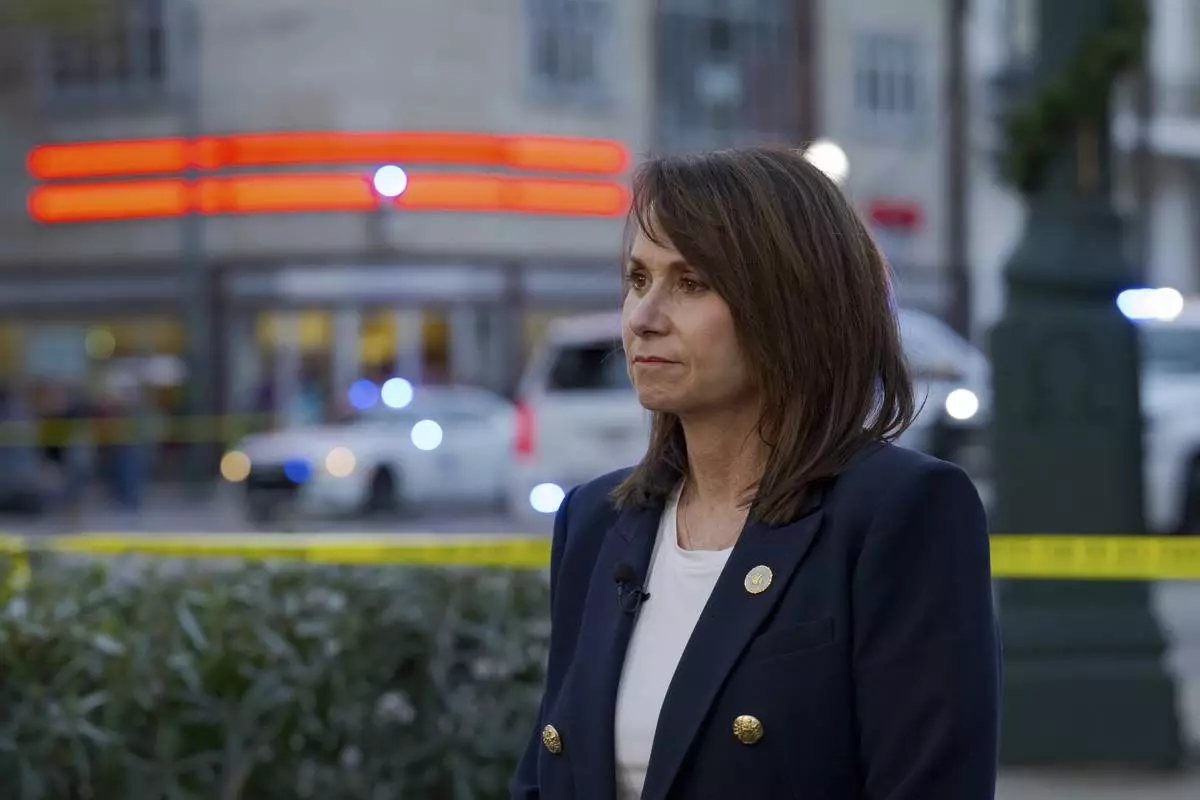
FILE - Louisiana Attorney General Liz Murrill speaks to reporters, Jan. 1, 2025, in New Orleans. (AP Photo/Matthew Hinton, file)

FILE - Children smile from window of a school bus in Springfield, Mass., as court-ordered busing brought Black children and white children together in elementary grades without incident, Sept. 16, 1974. (AP Photo/Peter Bregg, File)
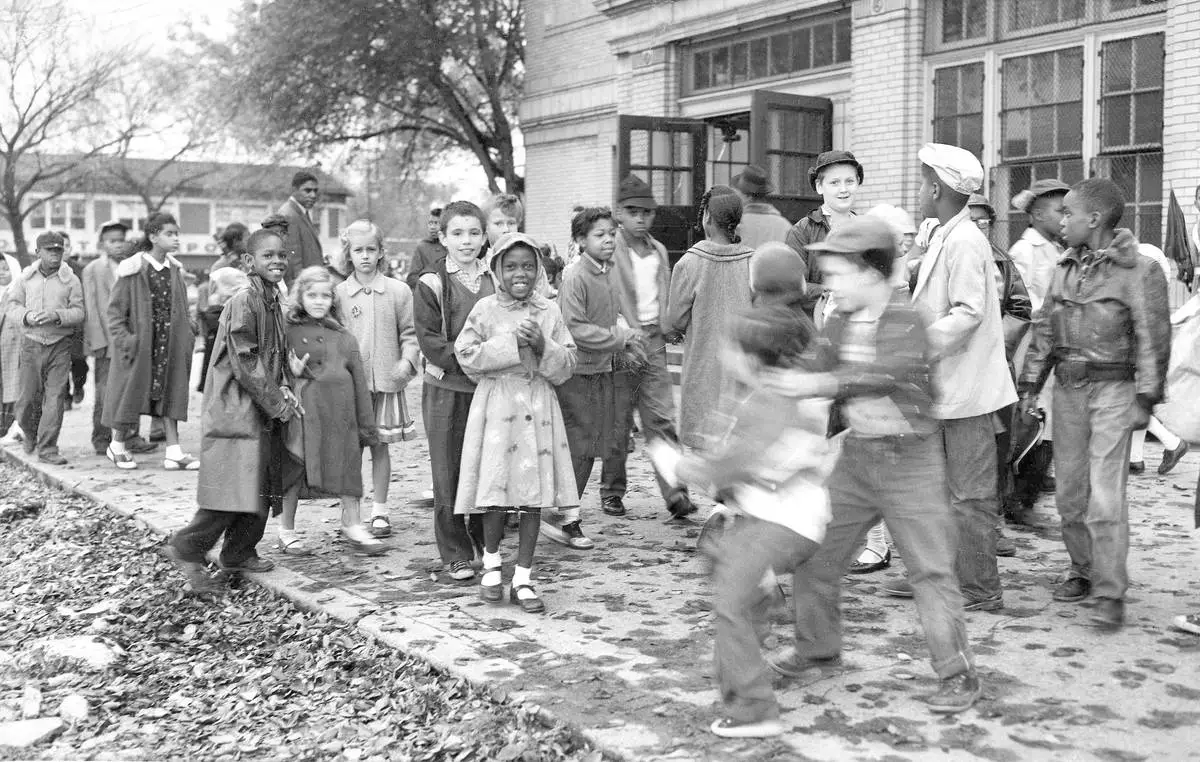
FILE - White and Black children mix freely on the playground outside a school in a racially mixed neighborhood, Oct. 18, 1957, in Detroit. (AP Photo/Alvan Quinn, File)
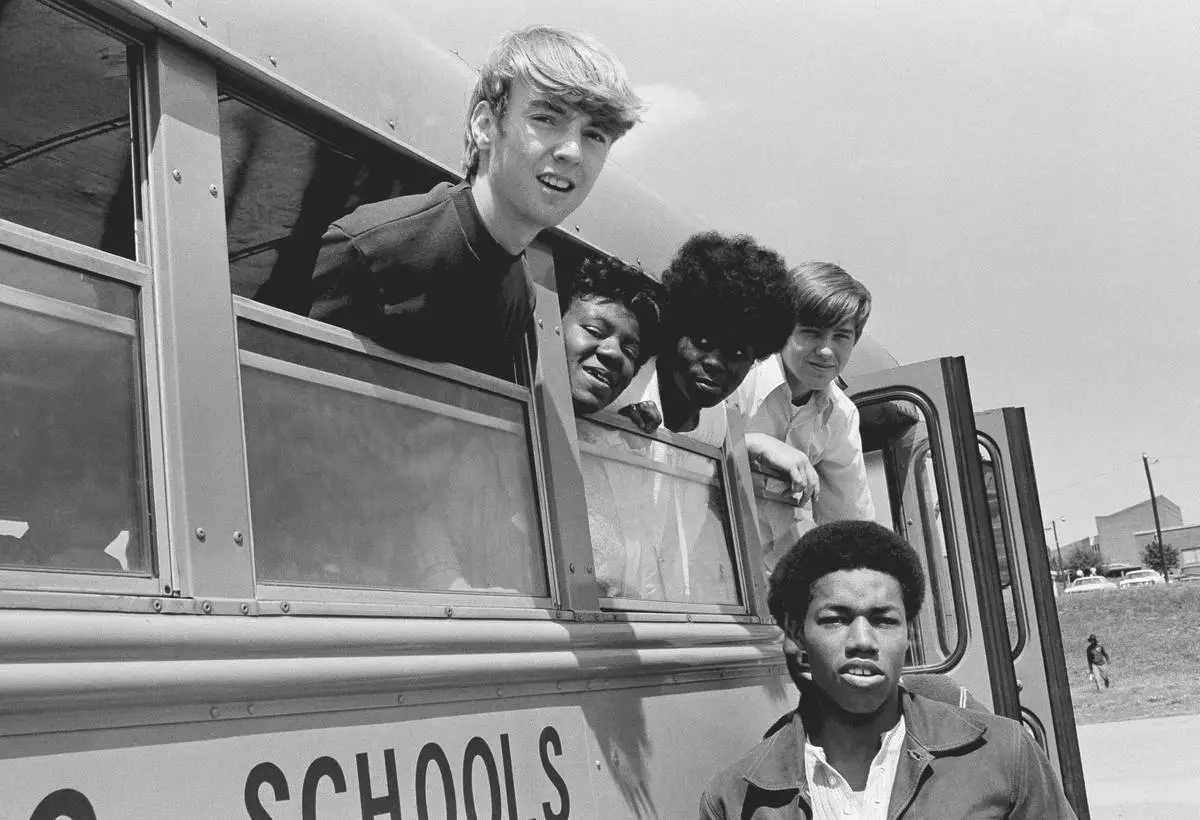
FILE - Students from Charlotte High School in Charlotte, N.C., ride a bus together, May 15, 1972. (AP Photo/Harold L. Valentine, File)
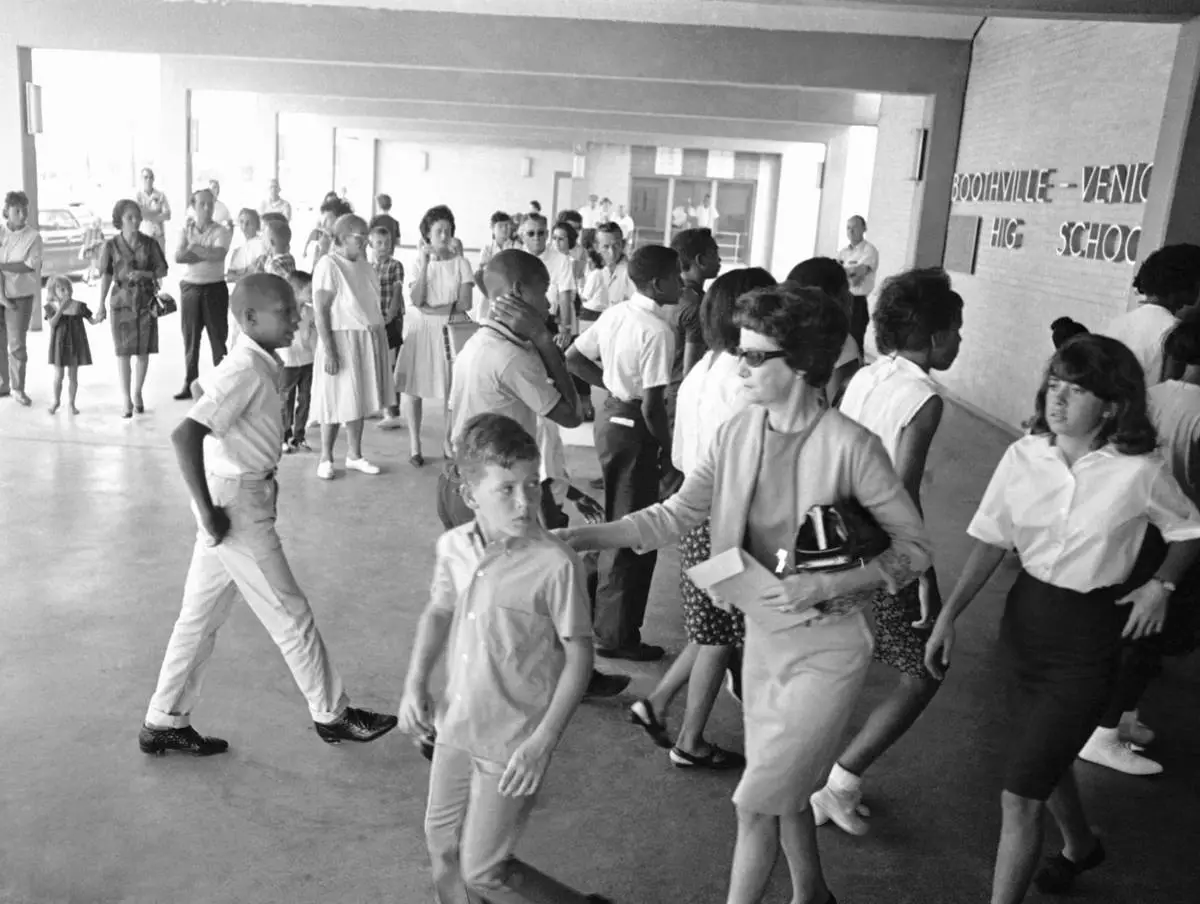
FILE - A white mother walks with her son past a group of African American students arriving for classes at formerly all-white Boothville Venice High School on Monday, Sept. 12, 1966 as racial barriers fell in Plaquemines Parish. (AP Photo/Jack Thornell, file)
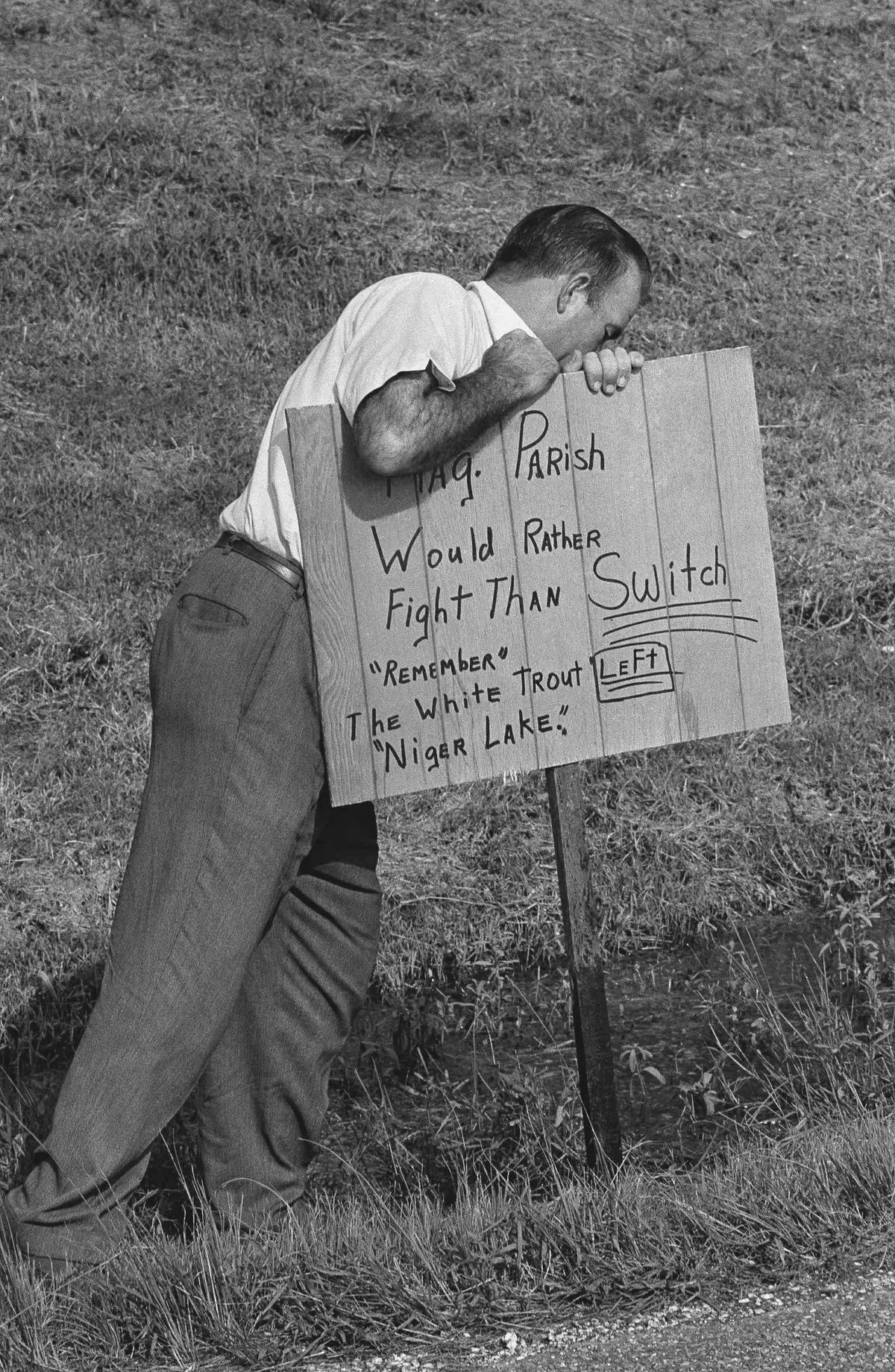
FILE - A man plants a sign reading outside Woodlawn High School in Pointe a la Hache, Louisiana on Sept. 1, 1966 where five African Americans applied for registration for the first time in parish history. (AP Photo/Jack Thornell, file)
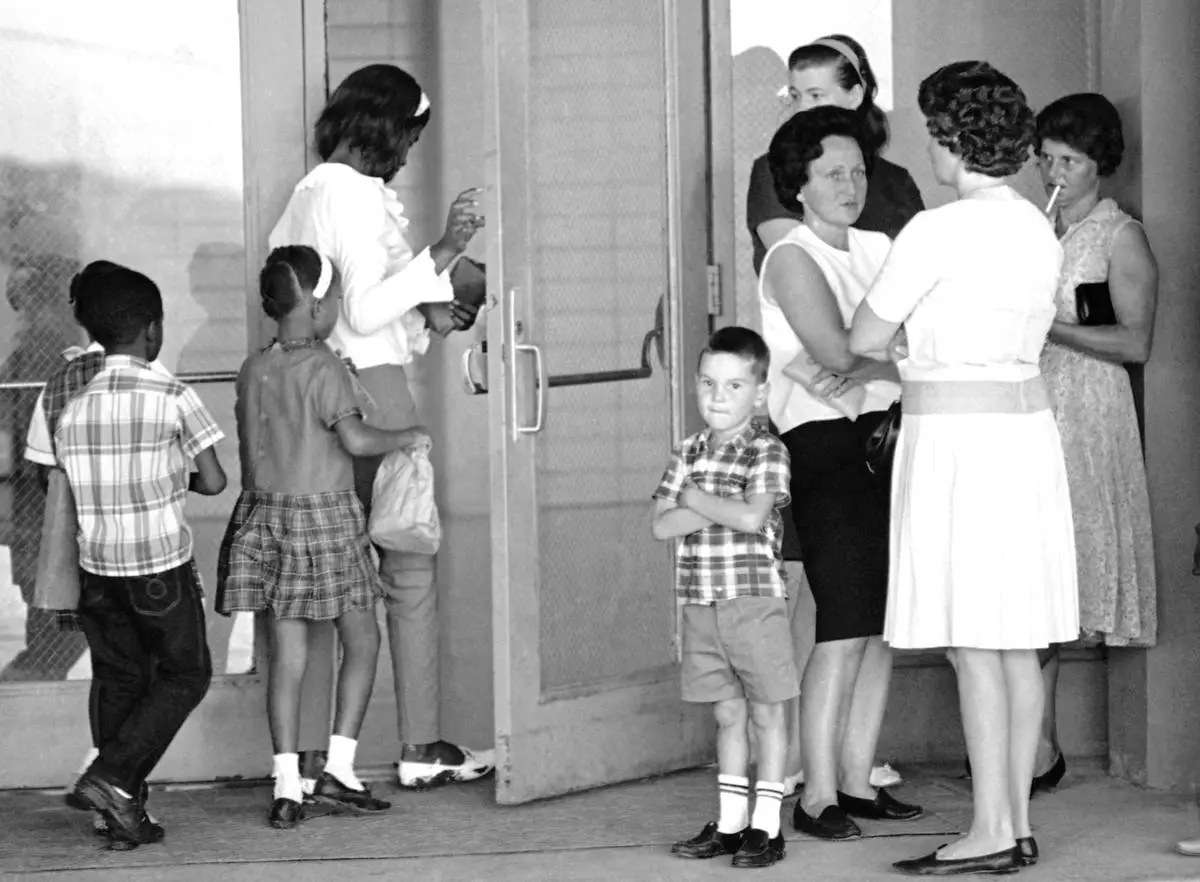
FILE - A group of African American students, left, enter the Boothville-Venice School in Plaquemines Parish, Louisiana on Sept. 12, 1966 as a group of white mothers wait at the entrance of the school. (AP Photo/Jack Thornell, file)



